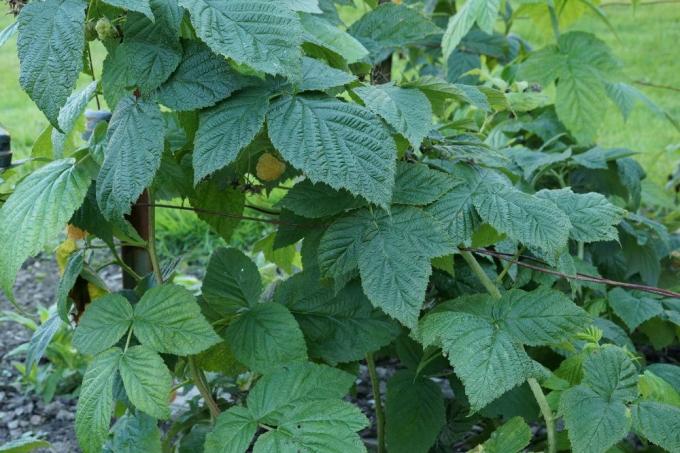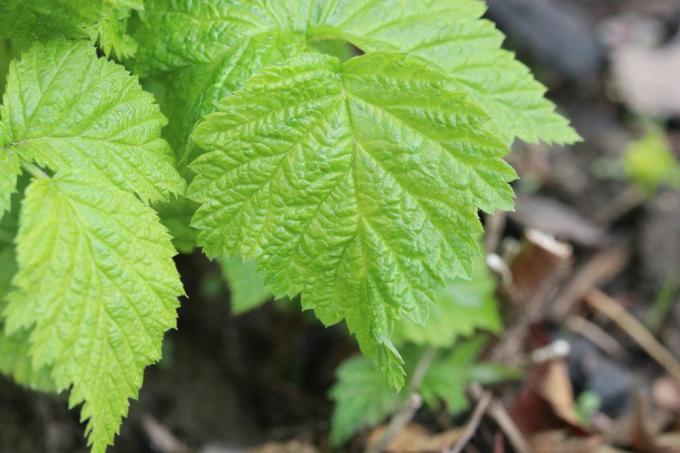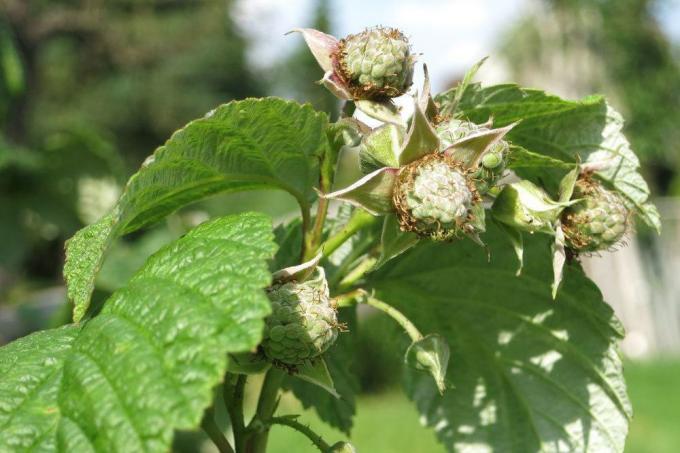
table of contents
- Different varieties for planting
- Be careful when planting offshoots
- The right planting time
- Location and soil
- Preparation of perennials and planting
- Attachment
- Important measures to complete the planting process
Raspberries (Rubus idaeus), alongside currants and strawberries, are the fruit carriers that hobby gardeners plant most frequently in their gardens. The fruits owe this on the one hand to the very good taste and on the other hand to their productivity despite relatively easy care. Important prerequisites for good harvest results are planting at the right time, the right location, the nature of the soil and the correct handling of the young plants.
Different varieties for planting
Lovers of fresh raspberries should have two varieties next to each other in the garden in order to be able to harvest over a longer period of time. These are the summer raspberries, also known as early raspberries, which only bear once a year, and the autumn raspberries, which are also known as late raspberries. In the case of summer raspberries, the fruits grow on the previous year's branches. They can be harvested from June. Autumn raspberries bear fruit not only on the so-called annual wood, but also on this year's canes.
The most famous varieties of summer raspberries include:
- Rubaca
- Glen Ample
- Tulameen
- Wei-Rula
and for the autumn raspberries:
- Autumn Bliss
- Autumn First
- Himbo top
- polka
Be careful when planting offshoots
Anyone who is already bothering to create a new bed of raspberries should buy genuine new young plants. This is the only way to ensure that they are guaranteed to be disease-free. Hobby gardeners are repeatedly offered plants by neighbors or friends.
These are usually offshoots from their gardens that can be infected by fungi or viruses. This in turn would mean that you would bring a lot of diseases into your laboriously newly created bed. In other words: Well-intentioned neighborly help with new plants is in many cases a disservice.

The right planting time
For most raspberry varieties, the correct planting time for young perennials is early autumn. Therefore, you should plan in October as the time for this work. Since the sun is no longer shining so strongly, the young plants are better protected from drying out than in spring or summer.
When planting in autumn, the root cuttings or cuttings still have enough time in well-prepared soil to form new roots. If you still miss this best planting time, you can plant summer raspberries as well as autumn raspberries in early spring if necessary. However, the time until the first bloom is no longer sufficient to be able to harvest a lot or anything at all in the same year. Therefore, autumn is always recommended as a time for planting.
Location and soil
In addition to the correct planting time, the hobby gardener must also pay attention to the right location. A partially shaded to sunny spot in the garden is best. It would also be ideal to choose a place sheltered from the wind. Raspberry varieties that bear fruit in autumn, however, only need locations in full sun.
Since summer raspberries as well as autumn raspberries prefer deep, humus-rich, loose and moist soils, places with waterlogging should never be selected as a location. If you are planting raspberries again, you shouldn't choose a place where raspberries have been before, otherwise the soil will quickly become fatigued.
The soil for planting young raspberry bushes should be rich in humus, deep and loose. A pH value between 5 and 6.5 with good ventilation is recommended. It is ideal if the soil is thoroughly prepared by loosening it thoroughly before planting the summer or autumn raspberries. Especially in loamy soils, it is advisable to incorporate a mixture of beef compost and garden compost in a ratio of 1: 1.

All raspberry varieties are susceptible to root and rod diseases, a consequence of waterlogging, which often results from compaction of the soil. If the soil, which tends to become waterlogged, is too loamy, the incorporation of sand can be helpful. As an alternative, it has proven useful to create a 20 cm high hill bed for planting the perennials.
Experts in nutrient-rich soils advise preparing the intended soil for the future summer raspberries or autumn raspberries before the time to plant the cuttings. So-called green manure can be sown on the planned location as early as August, e.g. B. with mustard seeds or bee pasture.
This will be submerged before the raspberries are planted in October. The result is a deeply loosened soil that remains weed-free and at the same time is supplied with new nutrients.
Preparation of perennials and planting
Before planting, the root cuttings are prepared for later healthy growth. This includes cutting young shoots back to just under 30 cm, shortening healthy roots by 1 cm and completely cutting off dead roots. Then you dip the root ball for approx. 10 to 15 minutes in water.
Alternatively, field stock or field stock can be used instead of water, which prevents root diseases. During the following planting process, the still bare-root young plants must not dry out. After the preparatory measures, the root cuttings should be planted in such a way that the buds on the root ball are covered a good 5 cm with soil.
The best distance between the individual cuttings is 40 to 50 cm so that the plants later receive sufficient light and are well ventilated. If several rows of summer raspberries and autumn raspberries are to be planted, a distance of 1.2 to 1.5 m between the rows is recommended. This leaves approx. 50 cm wide paths to walk on the raspberry plant without fear of compaction of the soil with the consequence of root diseases (see above).
Attachment
Summer raspberries and fall raspberries are similar to blackberries spreading climbers, which means they need some climbing aid. It is advisable to build a small scaffold to support the later fruit-bearing tendrils. As a rule, a simple trellis made of wooden stakes, between which three lines or wires in approx. 50, 100 and 150 cm high.
The new tendrils can be attached to this to enable space-saving growth and later easy harvest. So that the fresh cuttings can take root in peace and can supply them with fresh nutrients undisturbed you set up the trellis immediately with the planting, but in any case no later than a height of 15 cm.

Professionals for planting berries on trellises recommend not simply tying up the later tendrils using the connecting wires. It would be better to also stretch a coarse-meshed net over the trellis. If you pull the freshly grown rods outwards through the mesh, they get significantly more light. Accordingly, many more flowers and thus fruits can be formed.
Important measures to complete the planting process
As soon as the fresh cuttings of summer raspberries and autumn raspberries are in the ground, you should make sure that it is protected from over-wetting and drying out. It is helpful to mulch the entire area with dried autumn leaves or lawn clippings after the young raspberries have been planted.
Since summer raspberries and autumn raspberries are not particularly hardy, precautions should also be taken with light winter protection when planting in autumn. The young cuttings can then grow better. In the past, it has been proven time and again to spread a layer of ripe compost or fir branches on the bed for protection.
Many hobby gardeners do not take into account that raspberries are very fond of proliferation. On the one hand, this creates problems for other plants in the immediate vicinity in the garden. On the other hand, the raspberries concentrate primarily on searching for water and building roots. You therefore need too much water and neglect the supply of rods and fruit.
To prevent this and to tame the root runners, it makes sense to enclose the rows of beds, which are about one meter wide, with a root barrier. The easiest way is to lay an approx. 25 cm wide pond liner. A more solid alternative is an edge made of lawn edging, which is usually medium-sized curb stones made of concrete.


